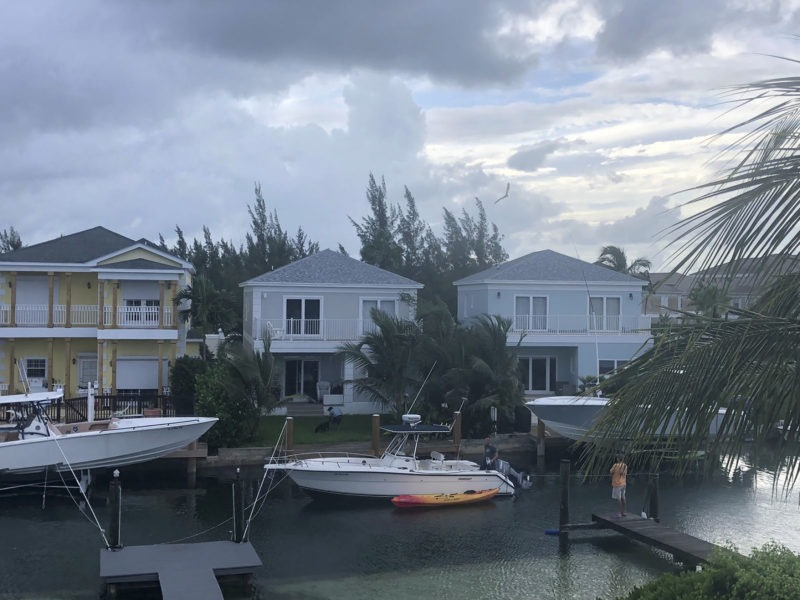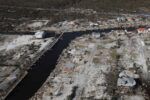‘Catastrophic’ Dorian strikes Bahamas with full fury
Boats tied up in preparation for the approach of Hurricane Dorian on September 1, 2019 in the Bahamas capital Nassau (Lucy WORBOYS)
Miami (AFP) – Hurricane Dorian unleashed “catastrophic conditions” Sunday as it slammed into the northern Bahamas, lashing the low-lying island chain with devastating 185 mph (295 kph) winds, the most intense in its modern history.
The monster Category 5 storm made landfall at Elbow Cay in the Abaco Islands at 1645 GMT, according to the Miami-based National Hurricane Center, which reported winds gusting over 220 mph.
“This is a life-threatening situation. Residents there should take immediate shelter,” it said, predicting a towering storm surge of 18 to 23 feet.
Local radio reported that people were calling for help after winds blew the roof off the Island Breezes Hotel in Marsh Harbor, a commercial hub in the Abacos.
“Things are really starting to rock and roll,” a post on the Facebook page of the Hope Town Bulletin in Abacos said at 10 am local time. “Limbs cracking and popping now,” said another.
Many Abacos residents were reported to have opted to ride out the hurricane rather than heed government warnings to evacuate.
The Nassau Guardian quoted local resident Troy Albury as saying 150 people stayed behind in Guana Cay, in the center of the Abacos, to face the storm’s fury. Only eight left on the last ferry out, he said.
Power went out as the storm approached, a resident of Man-o-war Cay in the Abacos told AFP.
The NHC said Dorian had become “the strongest hurricane in modern records for the northwestern Bahamas.”
“Catastrophic hurricane conditions are occurring in the Abacos Islands,” the forecaster said in its 1800 GMT bulletin.
It said the storm was “heading with all its fury towards Grand Bahama” where it was expected Sunday night into Monday.
NHC director Ken Graham on Facebook Live said the Bahamas would be under major hurricane conditions for a punishing 30 hours or more.
“That’s major hurricane winds, that’s storm surge of 10 and even 20 feet in some of those areas,” he said. “That’s also torrential rainfall of 15 to 20 inches, isolated 30 inches.”
In Washington, US President Donald Trump met with his emergency management chiefs and declared “this looks monstrous.”
“We expect that much of the eastern seaboard will be ultimately impacted and some of it very, very severely,” he said.
Tropical storm warnings were in effect for parts of the Florida coast, and residents up and down the Atlantic coast braced for a brush with danger.
Florida issued its first evacuation orders in parts of Palm Beach, home of Trump’s Mar-a-Lago resort, and Martin Counties.
In Grand Bahama, meanwhile, businesses were boarded up and thousands have evacuated Dorian’s predicted path.
“It feels like we are standing in a line waiting for a beating,” Yasmin Rigby, a resident of the island’s main city Freeport, told AFP.
Prime Minister Hubert Minnis has warned residents “the price you may pay for not evacuating is your life or other serious physical harm.”
– ‘Very great danger’ –
Trump canceled a high-profile trip to Warsaw to focus on storm preparations.
“It’s just been building out there and moving very slowly,” he said at a meeting with Federal Emergency Management Agency officials. “It’s a bad thing, not a good thing. The slower it is, the bigger it is and the bigger it gets.
Kevin McAleenan, acting homeland security secretary, said hurricane force winds could hit Florida, followed by a prolonged rain event, combined with a storm surge.
“That’s going to be very difficult as the storm starts to move northward, mostly like, up the coast of Florida and toward Georgia and South Carolina,” he said on ABC’s “This Week.”
While Miami appeared likely to be largely spared, 30-year-old David Duque, picking up sandbags there on Saturday, noted “everything could change… I know it could be a scare, but better prepare instead of doing nothing.”
The Florida National Guard said roughly 2,000 service members had been mobilized, with another 2,000 poised to join them.
– ‘Absolute monster’ –
Trump has declared a federal state of emergency in Florida, authorizing US assistance to supplement state and local efforts.
Following a similar state order in Florida, South Carolina Governor Henry McMaster declared a state of emergency Saturday, saying, “Given the strength and unpredictability of the storm, we must prepare for every possible scenario.”
Neighboring North Carolina also declared a state of emergency, and Georgia announced a state of emergency for 12 counties.
The US Coast Guard said large commercial vessels should plan to leave ports from south Florida to Savannah, Georgia, and advised pleasure craft to seek safe harbor.
Orlando International Airport was to protectively halt commercial flights at 2:00 am (0600 GMT) Monday, and Florida’s NASA Kennedy Space Centre said it was moving an enormous mobile rocket launcher inside to protect it.
Disclaimer: Validity of the above story is for 7 Days from original date of publishing. Source: AFP.


